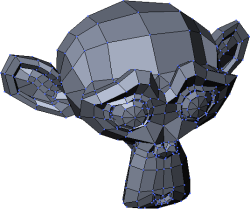I am old enough to remember when stores like Radio Shack in the mall had computers sitting on display with nothing but a cursor blinking on a command line. There was no program running, no user interface to interact with. Inevitably the screen would look something like this (edited slightly to keep this blog PG):
 HELLO
HELLO
SYNTAX ERROR: ‘HELLO’ IS NOT A COMMAND
WHAT IS A COMMAND
SYNTAX ERROR: ‘WHAT’ IS NOT A COMMAND
*&!# YOU
SYNTAX ERROR: ‘*&!#’ IS NOT A COMMAND
It’s hard to know what people who put the computers expected to happen. But what looks like vandalism isn’t, really. What probably happened here is that a kid who didn’t know how to work with a computer tried, assuming the computer would be designed to be cooperative. When they found it wasn’t, they had a normal angry reaction.
Recently I was co-teaching a class where the other teacher was teaching kids Blender. I knew Blender less than some of the kids, so I was more a fellow student than a co-teacher. But I’m also a grown-up , so I studiously mimicked my co-teacher’s lessons, and soon learned a lot.
, so I studiously mimicked my co-teacher’s lessons, and soon learned a lot.
Some of the other kids did that too. But others, when it came to selecting the starting shape, picked not a sphere or a column but Suzanne, Blender’s built-in monkey head shape. Then they randomly selected various panels and stretched them in random directions until Suzanne looked like a jigsaw puzzle with a coupla pieces gone.
My co-teacher was incredibly patient, but I could feel his frustration. “Okay, that’s nice,” he said, on seeing the twisted parody of a monkey. “Now start again and follow the instructions please.”
If you’ve taught kids on computers you are familiar with this problem. I encounter the same thing when my kids, instead of naming their objects MySprite call them something like IAMLAZARRRRRR (and then can’t spell it when they try to refer back), or make a video game where all the sprites, the background and the obstacles are Nicholas Cage’s head or Honey Boo-Boo’s mom so you can’t see what’s going on.
To a child psychologist, what is happening is clear and predictable. When introduced to a new environment, kids start testing the extremities and boundaries. They want to see what can happen, what they can get away with. Play is the work of a child, as it’s said, and play is a step in learning.
From a teacher’s point of view, though, the problem is clear. In a specialized field like programming or using an advanced program there are narrow paths to success through wide fields of failure. The keys of a piano can be struck in an infinite number of ways, but only an insignificant portion of those will make a song. There is a tiny chance a kid will discover something useful this way, but the more advanced the system they’re working in the less likely they will.
Also, you have a lesson plan, and they are missing out on it as they screw around! You have got to get them on track NOW or they will be forever behind!
A hint to working with children: when you find yourself saying “I have to fix this NOW,” you’re courting failure (except, obviously, for situations where the children are literally in danger).
Firmly discouraging a child’s play is likely to lead to disinterest and alienation. So what do you do instead?
Here’s what I do:
“That’s a weird result! How did you get that?”
(Yes, I usually know, but I’ll let them tell me.)
“Wow, that’s cool, I’m going to try that later myself! Hey, I want to give you time to experiment later, but can you do the lesson right now, because I don’t want you to get behind.” (Yes, you really do have to give them time to experiment later.)
Of course this always gets them back on task 100% of the time. Haha, just kidding. They will probably continue to screw around and do inappropriate things sometimes. But at least you haven’t discouraged their natural curiosity, and in the future you can start to try to direct it.
As you go along, give them places where exploratory actions can get them useful results. Start to define boundaries for play that will get them somewhere. When they see this happening, they will become eager and want to follow it further. Now they’re on the hook, and you can start to reel them in!